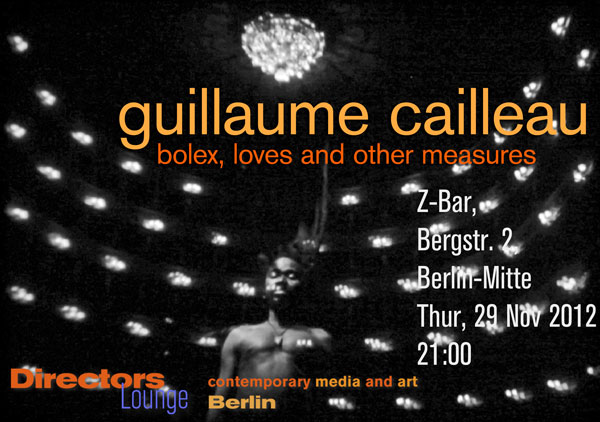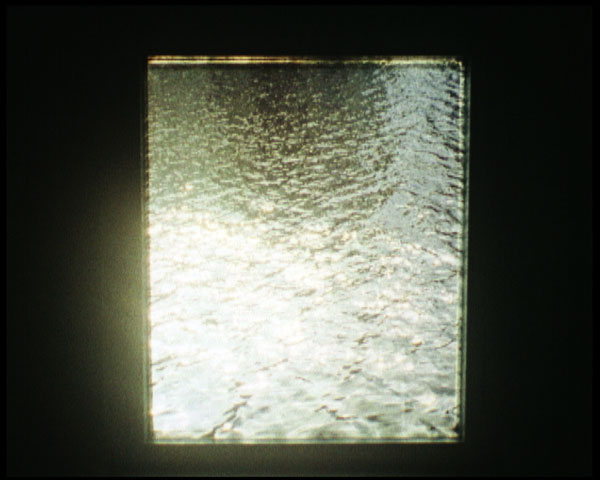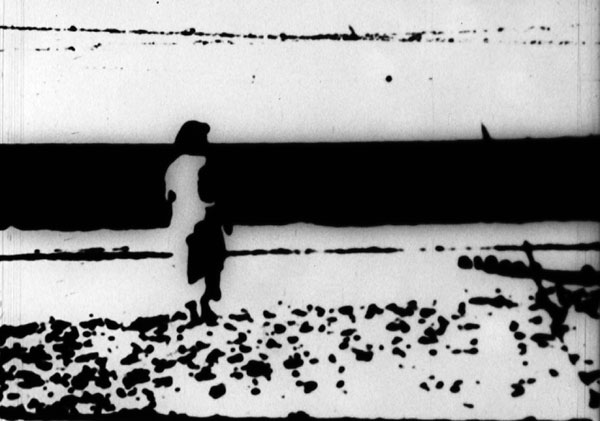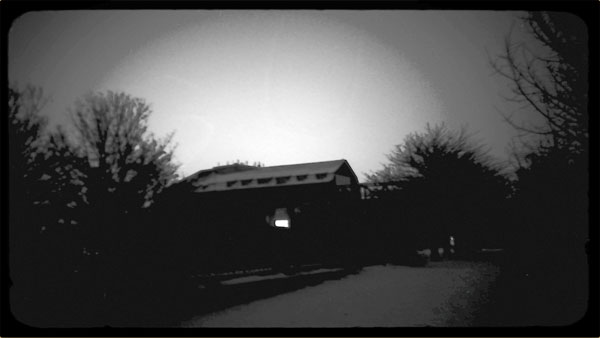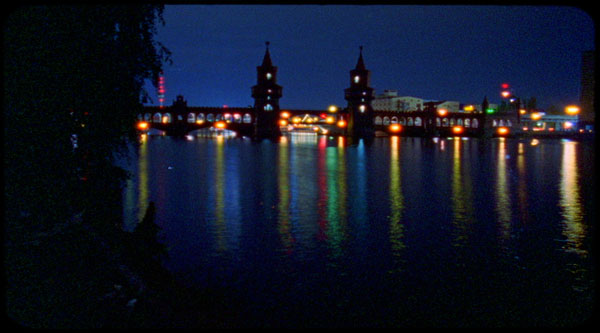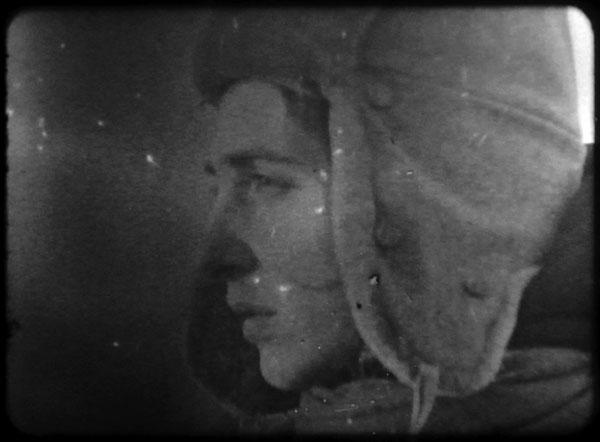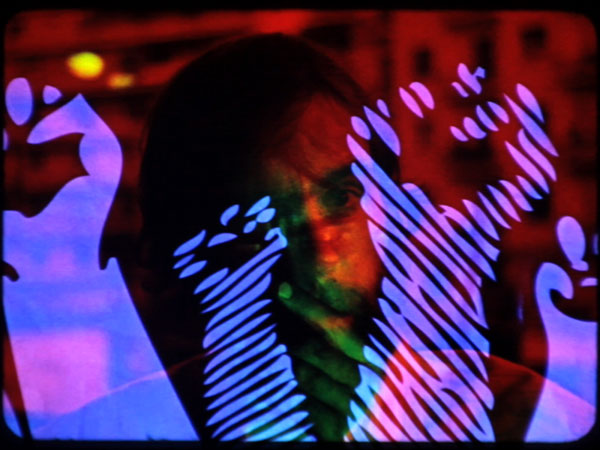 |
directors lounge monthly screening
Guillaume Cailleau
Bolex, Loves and Other Measures
16mm and Live Super-8 Performance
Donnerstag, 29. November 2012
21:00 Uhr
Z-Bar
Bergstraße 2
10115 Berlin-Mitte
Bolex, Liebe und andere Maßnahmen
Guillaume Cailleau arbeitet vornehmlich mit Film, 16mm und Super-8, aber nicht ausschließlich. Der Wahl-Berliner und studierter Ingenieur kam nach Berlin um hier Film bzw. Kunst zu machen und ließ seinen Ingenieurfreundeskreis in Paris zurück. Obwohl er sich häufig auf die Tradition der Avantgarde bezieht, spürt man bei seinen Arbeiten gleichzeitig eine streng konzeptuelle Auffassung, aber auch einen spielerischen Umgang mit den Mitteln. Er sagt “die Avantgarde hat die Mittel entwickelt und heute kommt es darauf an, sich damit auszudrücken." Er gehört damit zu einer neuen Generation von Künstlern, die sich wieder auf das künstlerische Filmemachen der 20er in Europa und der frühen 60er Jahr in USA und Großbritannien beziehen, und die im Gegensatz zur zweiten Generation nach 1968, wie Hollis Frampton und Ernie Gehr, sich nicht mehr um konzeptuellem Purismus bemüßigt sehen. Sie finden zu einer lustvollen Freiheit zurück, wie sie die Anfänge der Avantgarde eigentlich ausgezeichnet hat. Allerdings handeln sie sich damit auch klassische Probleme der Kunst wieder ein: Wie Cailleau sagt, ringt er um eine Einheit von Inhalt und Form. Zugleich spielen für ihn zwei weitere klassische Avantgarde-Themen ein Rolle: Expanded Cinema als Live-Performance und die Untersuchungen der visuellen Wahrnehmung.
Die beiden letzten spielen eine große Rolle im ersten Programmteil:
#2.06 besteht aus zwei Loops von Super-8 Projektoren, mit jeweils der Bildfolge Rot-Grün-Blau-Rot und Yellow-Magenta-Cyan-Yellow. Die zwei Projektionen erfolgen übereinander mit unterschiedlichen Geschwindigkeiten und variabler Größe, Schärfe und Bildstrich. Dazu performt Jan Slak technisch brilliant und scheinbar synchron mit Base-Drum und kleiner Trommel.
Diese audiovisuelle Performance arbeitet mit den Grundlagen von Film ähnlich wie Filme von Paul Sharits mit den Grundfarben des additiven und subtraktiven Farbsystems (bzw. von Farbpositiv und Farbnegativ). Zugleich stellt sich ein unerwarteter Spassfaktor ein: je nach Konzentration und eigener Wahrnehmung werden virtuell andere Farbkombinationen sichtbar, und zugleich erscheint der Sound wie an die Projektion gekoppelt zu sein um sich dann doch wieder von ihr zu lösen.
Das Prinzip der Farbtrennung nimmt der Künstler dann wieder auf mit seinem Filmprojekt “Austerity Measures", eine Zusammenarbeit mit US-Filmemacher Ben Russell in Athen. Die Trennung der Farben geschieht hier nicht live bei der Performance, sondern in einem aufwändigen Prozess beim Filmen selbst: Jeder Teil des Filmes wurde dreimal belichtet, jeweils mit einem Filter der drei Grundfarben Rot, Grün und Blau, und zugleich nur in der Kamera geschnitten. Der Titel bedeutet im Sprachgebrauch der Ökonomen jene Lohn- und Sozialkürzungen und den neoliberalen Sozialumbau, die Staatspolitiker der “Geberländer" als Bedingung für die Rettung von Staatsfinanzen fordern. Der Film entstand 2011 während Guillaume bei einen Filmworkshop des Filmkollektivs LaborBerlin unterrichtete; zu Gast im LabA im Szene- und Alternativviertel Exarchia in Griechenland, als die jetzigen Proteste gegen die Sparauflagen der EU schon aufflammten. “Austerity" bedeutet aber eigentlich auch Enthaltsamkeit und kann auch auf eine bestimmte Askese des Filmemachens bezogen werden: Dass der Film sich gar nicht anmaßt, die politischen Umstände oder Bewegungen in Exarchia zu dokumentieren, sondern sich bescheidet, ein Stadtviertel mit äußerst sparsamen Mitteln zu beschreiben (in der Kamera geschnitten, und selbst entwickelt) und mittels zweier Portraits, einigen Stadt-Impressionen und Graffiti-Oberflächen. Die Farbtrennung, die zum Teil wieder “realistisch" zusammengefügt wird, mit nur leichten Irritationen der kleinen “Fehler" und zum Teil so auseinander läuft, dass zum Beispiel ein Gesicht als irisierende Dreifachbelichtung erscheint, erinnert zum Teil an Einfärbungen von Schwarzweißfilm, wie sie D. W. Griffith bei “Birth of a Nation" 1915 verwendete, frühe Farbexperimente bevor es Farbfilm gab. Überhaupt ist es interessant, dass diese frühe Farbtechnik, drei getrennte, unterschiedlich farbgefilterte Aufnahmen zusammenzufügen, gerade heute (nicht nur) von Guillaume Cailleau wiederbelebt wird, wo digitale Aufnahmen und Bearbeitungstechniken den analogen Film endgültig zu verdrängen scheinen, gerade da die digitale Technik noch viel stärker auf der Reduzierung auf die Lichtfarben Rot, Grün und Blau beruht um Oberflächenfarben darzustellen, die eigentlich ganze Farbspektren enthalten.
“H(i)J" basiert auf ganz anderer Verfahrensweisen und Inhalten. Guillaume stellt dem Film voraus, dass er eine Hommage oder Erinnerung an die Geburt seinen Sohnes sei, an jene Nacht, als er seiner Freundin beistand, das gemeinsame Kind zur Welt zu bringen. Der Film ist fast komplett am optischen Printer, einem sogenannten JK, entstanden, mit dem er Filmmaterial auf Hochkontrast-Schwarzweissfilm umkopierte. Der Künstler nutzte die Gelegenheit eines Studienaufenthaltes an der Cooper Union in New York. Entstanden ist dabei ein sehr poetischer Film in tiefen Schwarz- und Weißtönen, mit fast abstrakten Bildern, die jedoch sowohl symbolisch als auch atmosphärisch gelesen werden wollen. Die Reduzierung sowohl der Halbtöne als auch der Abbildungen: eine Frau am Meer, Klarfilm, Löcher im Filmmaterial und schließlich das Gesicht eines Kindes ermöglicht das freie Assoziieren, vielleicht um so mehr wenn man weiß, mit wieviel Mühen im einsamen dunklen Raum an zwei gekoppelten Bolexkameras die Herstellung des Films verbunden ist. Die nächtlichen Halbbilder scheinen sich geradezu auf dem entwickeltem Filmmaterial eingefangen zu haben.
In dieser privaten, lyrischen Ausdrucksweise stehen auch zwei Filme, die als Portraits, und Widmungen, gemeint sind. Selten zu sehende Filme, da der Filmemacher Cailleau diese nicht für festivalgeeignet hält. Beide Filme, “Abdou's dread in teatro Argentino, Roma" und "Lucile's Ghosts on Atlas Top, Bruxelles", sind verschiedene Arten von Inszenierungen vor der Kamera, zugleich zeigen sie die Personen aus der freundschaftlichen Sicht von Guillaume. Und sie mögen vielleicht auch stellvertretend sein dafür wie Freundschaften und Zusammenarbeit mit anderen Künstlern einen großen Einfluß auf den Künstler haben. Sei es durch die Zusammenarbeit mit Musikern, mit anderen Filmkünstlern, oder auch die Arbeit, die er für Theaterproduktionen macht. Sicherlich sind diese verschiedenen künstlerischen Verbindungen ein Grund für die Vielfalt in Guillaume Cailleaus Arbeit, und auch den Eindruck des freien Spielerischen, den man erhält, trotz der zum Teil strengen Konzeption der einzelnen künstlerischen Arbeit.
Der Künstler wird nicht nur die Filme selbst live vorführen, sondern wird auch zum Gespräch danach zur Verfügung stehen.
Künstler-Links:
http://lightcone.org/en/filmmaker-1910-guillaume-cailleau
Links:
Directors Lounge
http://www.directorslounge.net
Z-Bar
http://www.z-bar.de
 Back Back
|
 |
